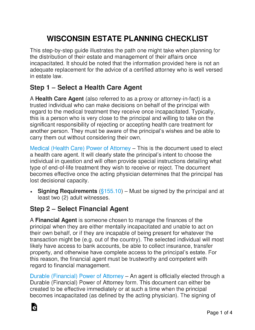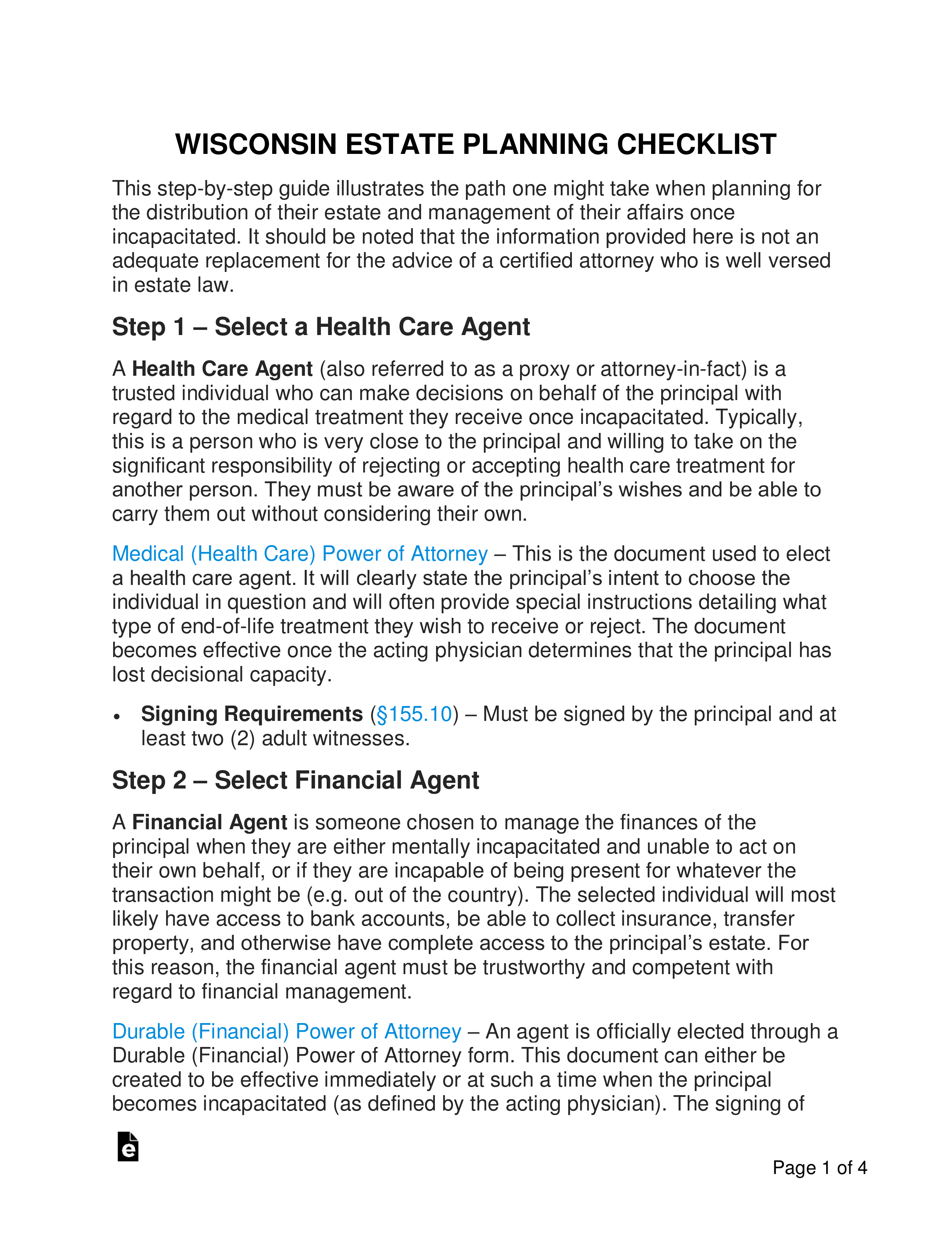Updated March 05, 2024
A Wisconsin estate planning checklist is a list of documents and steps one can use to organize their affairs for the end of their life. The process of estate planning involves naming beneficiaries, defining assets, naming executors, trustees, and attorneys-in-fact, deciding on end-of-life care, and generally planning for the loss of decisional capacity. When one is selecting financial and health care agents, they must choose someone trustworthy and accountable who can manage their medical treatment and finances once the time comes. The election of such individuals can be accomplished through a Durable Power of Attorney and a Medical (Health Care) Power of Attorney. A Last Will and Testament or a (Revocable) Living Trust, what most people think of when they hear “estate planning,” are the documents used to pass on an estate to beneficiaries following the owner’s death.
How to Create an Estate Plan in Wisconsin (6 steps)
- Select a Health Care Agent
- Select Financial Agent
- Make a List of All Assets
- Select and Inform Beneficiaries
- Create Estate Planning Documents
- Store Documents
This step-by-step guide illustrates the path one might take when planning for the distribution of their estate and management of their affairs once incapacitated. It should be noted that the information provided here is not an adequate replacement for the advice of a certified attorney who is well versed in estate law.
1. Select a Health Care Agent
A Health Care Agent (also referred to as a proxy or attorney-in-fact) is a trusted individual who can make decisions on behalf of the principal with regard to the medical treatment they receive once incapacitated. Typically, this is a person who is very close to the principal and willing to take on the significant responsibility of rejecting or accepting health care treatment for another person. They must be aware of the principal’s wishes and be able to carry them out without considering their own.
Medical (Health Care) Power of Attorney – This is the document used to elect a health care agent. It will clearly state the principal’s intent to choose the individual in question and will often provide special instructions detailing what type of end-of-life treatment they wish to receive or reject. The document becomes effective once the acting physician determines that the principal has lost decisional capacity.
- Signing Requirements – Must be signed by the principal and at least two (2) adult witnesses.[1]
2. Select Financial Agent
A Financial Agent is someone chosen to manage the finances of the principal when they are either mentally incapacitated and unable to act on their own behalf, or if they are incapable of being present for whatever the transaction might be (e.g. out of the country). The selected individual will most likely have access to bank accounts, be able to collect insurance, transfer property, and otherwise have complete access to the principal’s estate. For this reason, the financial agent must be trustworthy and competent with regard to financial management.
Durable (Financial) Power of Attorney – An agent is officially elected through a Durable (Financial) Power of Attorney form. This document can either be created to be effective immediately or at such a time when the principal becomes incapacitated (as defined by the acting physician). The signing of this document does not transfer the power to manage finances from the principal to the agent but instead grants a second individual managerial authority. The term “Durable” refers to the power of attorney remaining intact following the principal’s incapacitation.
- Signing Requirements – Must be signed by the principal and the signature must be acknowledged before a notary public.[2]
Financial Powers Allowed:
- Real property
- Tangible personal property
- Digital property
- Stocks and bonds
- Commodities and options
- Banks and other financial institutions
- Operation of entity or business
- Insurance and annuities
- Estates, trusts, and other beneficial interests
- Claims and litigation
- Personal and family maintenance
- Benefits from governmental programs or civil or military service
- Retirement plans
- Taxes
3. Make a List of All Assets
4. Select and Inform Beneficiaries
5. Create Estate Planning Documents
An estate planning document is one that is designed to give instructions on how one’s estate will be divided upon their death. The type of document used will depend on the size of the estate and the complexity of the estate owners wishes. Generally speaking, a person will employ the use of a Last Will and Testament or a Revocable Living Trus; however, these are often used together.
Last Will and Testament – A Last Will and Testament provides instructions for an executor on how the testator (creator) would like their estate divided. It also will include provisions regarding guardianship and the settling of any debts and funeral costs. While this legal instrument can be created more quickly and with fewer costs than a Living Trust, it must pass through probate court before the beneficiaries can receive their portion of the estate.
- Signing Requirements – A Will must be signed by the testator and two (2) witnesses.[3]
(Revocable) Living Trust – A Revocable Living Trust, like a Will, passes the creator’s property to beneficiaries named therein. The trust creator is called a grantor, and the individual overseeing the distribution of assets is titled a trustee (or successor trustee if grantor names themselves trustee). The creation of a Trust is a more involved process as it is essentially creating a separate entity into which the grantor must transfer the ownership of their assets and property. Often a Pour-Over Will will be employed in conjunction with a Living Trust to cover any remaining assets and property. A Trust will not pass through probate, thus providing the beneficiaries with their inheritance in an expedited fashion.
- Signing Requirements – There is no statute that defines the signing requirements for a trust document; however, it will be necessary for the trust creator to sign.[4]
6. Store Documents
Wisconsin Estate Planning Laws
- Medical Power of Attorney – Chapter 155 Power Of Attorney For Health Care
- Durable Power of Attorney – Chapter 244 Uniform Power Of Attorney For Finances And Property
- Last Will and Testament – Chapter 853 Wills
- Revocable Living Trust – Chapter 701 Trusts
Sources


